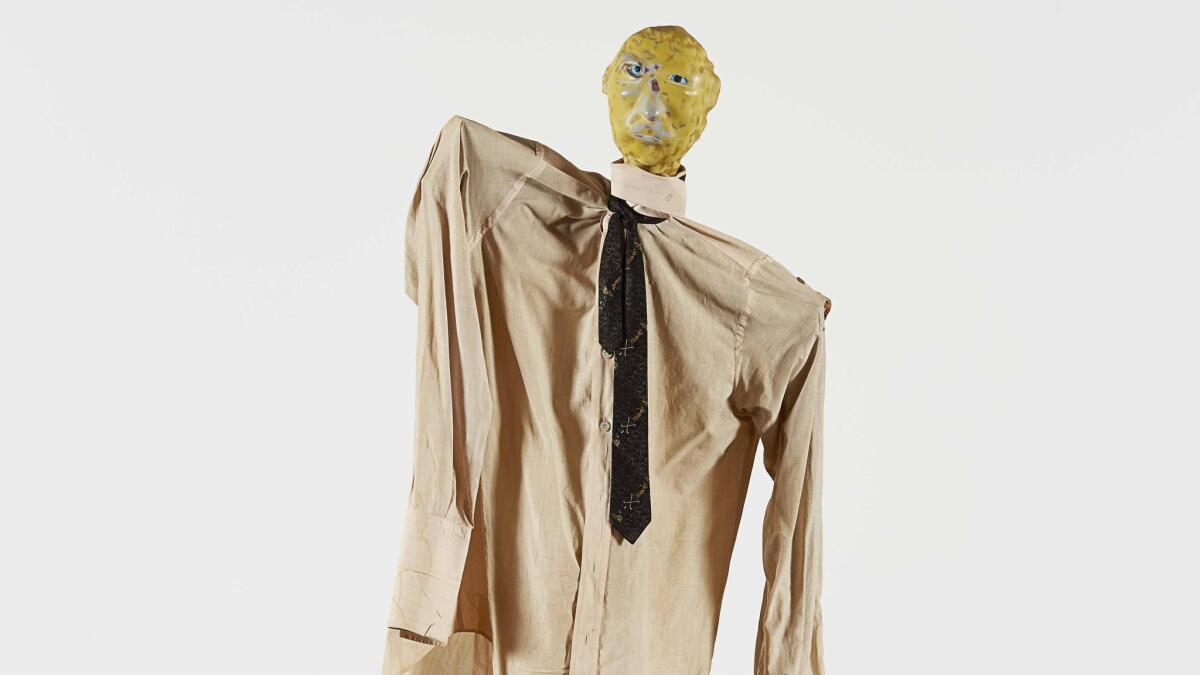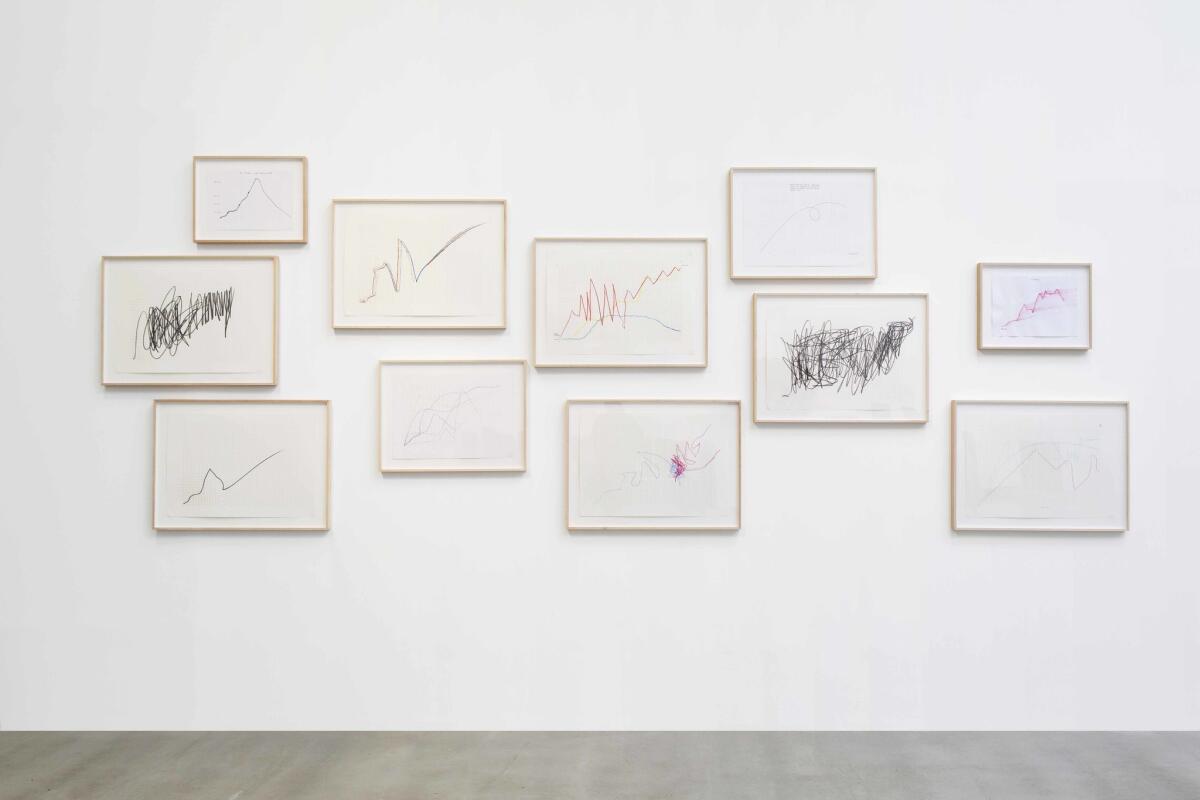Review: Jimmie Durham’s art throws some well-aimed stones
- Share via
Given deplorable declarations of American xenophobia now splashed across newspaper front pages, clogging social media outlets and upending television news shows, there could be no more impeccable a moment for a retrospective of Jimmie Durham’s art.
With nearly 200 sculptures, drawings, collages and videos, “Jimmie Durham: At the Center of the World” opened Sunday at the UCLA Hammer Museum. Durham, born in Arkansas in 1940, has shown internationally almost since enrolling in Geneva’s School of Fine Arts in 1969.
The Venice Biennale, Germany’s Documenta and the Gwangju Biennale in South Korea are on his resume, while retrospectives were held in France and Belgium in 2009 and 2012. Yet the Hammer’s much-anticipated exhibition is his first big American show in two decades.
Talk about the serendipity of timing. Durham, as described by critic Paul Chaat Smith in one of seven essays in the show’s hefty catalog, is “a stone-cold Cherokee Indian.” His art speaks with a voice that is otherwise only heard in American life at times of profound crisis, such as the massive protest underway against the Dakota Access Pipeline, led by the Standing Rock Sioux Tribe.
Some have disputed his tribal status, but Durham’s 1970s activism as a leader in the American Indian Movement is incontrovertible. Challenges to stubborn, colonial principles of identity politics have been his art’s bread and butter for more than four decades.

Identity politics got baked into American life in 1789, when constitutional rights and privileges were extended to white men, while the rest were offered arduous mechanisms for contesting their own diminished status. At its best, Durham’s work flares with blunt energy, the catharsis of sly wit and the subtle nuance of pressing if unanswerable questions.
Just what that means for the artist, as well as for any indigenous people (and indeed, anyone) in societies erected atop colonial foundations, is a durable thread in the show. I thought of Smith’s “stone-cold” description when looking at “St. Frigo,” an ordinary refrigerator that Durham set up outdoors on a lawn and pelted with rocks for a week. A battered carcass remains.
One element that’s beat up is ’60s art. A refrigerator is a staple of classic Pop by painters as diverse as Peter Saul and Andy Warhol, while the sculpture’s cubic white form is Minimalist, like something by Sol LeWitt. Brutalized, “St. Frigo” is an eccentric martyr — resurrected from ruin as a new work of art.
Durham essentially did what any traditional sculptor does, chipping away to give specific form to an existing mass. That he took aim at a household appliance designed to keep perishables from going bad is at once an artistically poetic act and a socially furious encounter. And throwing stones suggests desperation, employed when one has little else for self-defense against hostility or indifference.
Much of Durham’s work is like that, using found objects and simple actions to operate on multiple levels.
Martyrdom as a surprising theological undercurrent is played out in a video, “Stoning the Refrigerator,” which records the making of “St. Frigo.” The Gospel of John tells of Jesus exhorting the mob in defense of a prostitute who is about to be stoned to death: “He that is without sin among you, let him first cast a stone at her.”
Durham does. We’ve got it on tape. He humbly accepts the risk of hypocrisy.
That mixed sense of cheekiness and humility turns up throughout the exhibition, which inaugurates architect Michael Maltzan’s handsomely redesigned Hammer galleries. (“Dubuffet Drawings: 1935-1962,” organized by New York’s Morgan Library, is also on view, as is a nicely spare installation of paintings from the eclectic Armand Hammer Collection.) Durham’s sculptures are anti-monumental.

Take “Head,” a bedraggled, papier-mâché gray ovoid lying on its side. One eye is a staring chip of turquoise stone, an ear a seashell. Dentures lurk behind parted lips.
Like Brancusi’s “Sleeping Muse,” Durham’s reclining head is reduced to simple forms. Yet inspiration here comes not from peaceful dreaming, as Brancusi hoped, but from the specter of violent death. His disheveled corpse-fragment rests on a metal plate — served up like John the Baptist’s head, severed at Salome’s decadent demand.
“Confessional,” made around the same time and hanging on a wall nearby, is a dirt- and acrylic-encrusted canvas lump, crumpled and smashed flat. Glass eyes, like those of a taxidermy animal or a 19th century Spanish Colonial saint, animate the ghost-like contour, which holds a sign: “Mr. Durham made me without stopping to think of his art career nor, I am sorry to say, the sensitivities of the general art public.”
The ensemble drapes like a hunter’s pelt — the flayed skin of ancient Greek satyr Marsyas, perhaps, peeled as punishment for his hubristic loss in an artistic challenge to divine Apollo.
“St. Frigo,” “Head” and “Confessional” all date from 1996, following the artist’s move to Berlin after nearly a decade in Cuernavaca, Mexico. Durham seems to work in bursts of concentrated activity, often keyed toward exhibition opportunities like Documenta and Venice.

Curator Anne Ellegood installed the show in a loose chronology. Durham, discharged from the Navy in 1963, started out by writing poetry and working in political theater related to civil rights causes. After art school in Switzerland he became a citizen of the world, living outside the U.S. as often as inside.
His modest sculptures are the kind of things that a homeless wanderer might cobble together, emphatically analog in a digital age awash in high-tech production values. Metaphorically assembled from rubbish and string, they are chiefly held together by keen if sometimes exhausted discernment.
The center of the world moves with him. For what does the term “Native American” really mean to indigenous people in societies centuries older than the United States?
President George H.W. Bush signed the well-intentioned but patronizing Indian Arts and Crafts Act, imposing five-year prison sentences plus fines up to $250,000 on people selling Indian art without government certification as a tribal member. Durham instead identifies as “a full-blooded contemporary artist,” member of the tribe of “sculptors.” State control over his identity — perhaps the ultimate act of colonization — gets a wry rebuke.

No wonder that, when he draws, sometimes it’s a ferocious scribble of pencil pressed hard on paper. Part inchoate assertion of unique calligraphy, it’s also part forceful temper tantrum.
Numerous works suggest veiled self-portraits — or even anti-portraits, describing who he resists being. One is a totemic wooden post dressed like a scarecrow in a soiled dress shirt and golf-patterned necktie (it’s as much a noose as an element of business attire), another a photograph with his face obscured by a stone slab.
The show’s sprawling size is a bit of a drawback. Two-hundred works are too many, and occasionally the work gets repetitive.
Perhaps the abundance was driven by a desire to take advantage of an opportunity with an expat American artist rarely seen in American museums. Yet that rarity is actually why an artist who should be better known should also be shown to the clearest, most rigorously organized curatorial advantage.
Still, it’s a bracing event. “Something … Perhaps a Fugue or an Elegy” is the show’s unequivocal masterpiece, a 2005 assemblage of broken-down electronics (cameras, TV, VHS player, etc.) interwoven in a horizontal path across the floor with seashells, tree branches, a cow skull, wood furniture and other natural elements. Robert Rauschenberg’s rebus-like assemblages come to mind, as do Rube Goldberg contraptions; but so does something surprising.
In the 1870s, during America’s first Gilded Age, artists like William Harnett began to make still-life paintings of disheveled tabletops loaded with second-hand books, torn newspapers, paper money, dog-eared sheet music and tattered violins, as well as doors draped with dead rabbits, ducks and antique firearms. Things not considered worthy of art and being run over by technology and greed were lovingly assembled, lavished with painterly care and hung for display in taverns and offices as often as museums — remembrances of lost virtues and ordinary pleasures.
Durham’s fugue or elegy is as great as Harnett’s revered “After the Hunt” pictures, painted by an earlier American refugee from the Gilded Age, who likewise opted to work in Germany. The sharp identity politics in Durham’s anti-monumental sculpture today resonates against another backdrop of purposeful chaos, lately being manufactured in Washington. Listen closely to its tenacious dirge.
christopher.knight@latimes.com
Twitter: @KnightLAT
ALSO
Christopher Knight’s latest reviews and columns
A raucous, rousing Trump protest show plays to a sold-out L.A. audience
Race, justice, power: Finding new relevance in Kurt Weill's 'Lost in the Stars'
The biggest entertainment stories
Get our big stories about Hollywood, film, television, music, arts, culture and more right in your inbox as soon as they publish.
You may occasionally receive promotional content from the Los Angeles Times.








